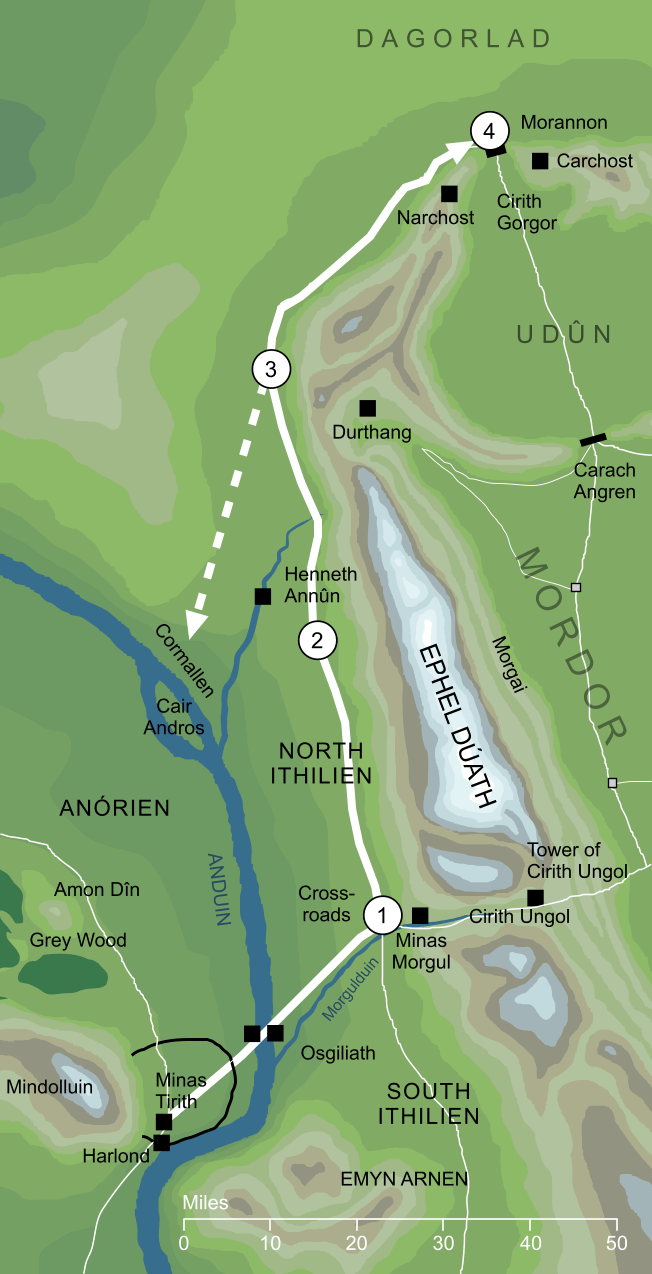- Cities and buildings
- Fields, plains and deserts
- Forests
- Hills and mountains
- Islands and promontories
- Lands, realms and regions
- Rivers and lakes
- Seas and oceans


|
||||
|


Which personality type are you?
Take the Free mydiscprofile Personality Test to discover your core personality and your ideal job.   Which personality type are you? |
|
Dates
Set out from Minas Tirith on 18 March III 3019; their battle before the Black Gate was seven days later, on 25 March
Location
Races
Primarily Men, but accompanied by the Wizard Gandalf, and with an Elf, Dwarf and Hobbit among their numbers
Divisions
Cultures
Gondorians and Rohirrim
Settlements
Meaning
Other names
Title of
|

The journey of the Lords of the West from Minas Tirith to the Gates of Mordor. (Note that some of the locations shown are necessarily approximate.) (1) At the Cross-roads they restore the broken statue there and divert briefly to break the bridge of Minas Morgul. When they depart, they leave a guard of Men behind to watch for enemies from the south. (2) At a cutting in North Ithilien they detect and avoid an ambush, slaying or driving off a small force of Orcs and Easterlings. From this point in the journey, they are watched from the skies by the Nazgûl. (3) At the edge of the Desolation of the Morannon, Aragorn sends away those overcome by fear to instead recapture and guard the island of Cair Andros. (4) The Lords of the West reach the Morannon after a journey of eight days. The journey of the Lords of the West from Minas Tirith to the Gates of Mordor. (Note that some of the locations shown are necessarily approximate.) (1) At the Cross-roads they restore the broken statue there and divert briefly to break the bridge of Minas Morgul. When they depart, they leave a guard of Men behind to watch for enemies from the south. (2) At a cutting in North Ithilien they detect and avoid an ambush, slaying or driving off a small force of Orcs and Easterlings. From this point in the journey, they are watched from the skies by the Nazgûl. (3) At the edge of the Desolation of the Morannon, Aragorn sends away those overcome by fear to instead recapture and guard the island of Cair Andros. (4) The Lords of the West reach the Morannon after a journey of eight days. Those lords and kings who accompanied Aragorn on the hopeless march from Minas Tirith to the Black Gate of Mordor in the closing days of the War of the Ring. As well as Aragorn himself, the Lords included Gandalf, Imrahil of Dol Amroth and Éomer of Rohan. They had no real hope of overcoming the forces of Sauron, but rather sought to distract his Eye and allow Frodo the Ring-bearer to achieve the Quest of Mount Doom and cast the Ring into the Fire. In this they succeeded: Sauron was defeated, and an Eagle flew to Minas Tirith bearing tidings of the victory of the Lords of the West over the Dark Lord. It should be noted that this is a very unusual use of the title 'Lords of the West'. In almost all cases, this is a title of the Valar, the Lords of Valinor in the West of the World. In this unique case, however, the title is evidently applied to the lords of the Westlands of Middle-earth who confronted the Dark Lord. Historically, when the Númenórean King Ar-Adûnakhôr claimed the title 'Lord of the West', this was considered to be nothing short of blasphemy against the Valar. The fact that Aragorn and his companions are so described without any such reservation is therefore remarkable, and perhaps shows how highly their achievement was esteemed. Notes
For acknowledgements and references, see the Disclaimer & Bibliography page. Original content © copyright Mark Fisher 2020, 2023. All rights reserved. For conditions of reuse, see the Site FAQ. Website services kindly sponsored by Discus from Axiom Software Ltd.Discus is one of the most powerful DISC personality profile tools, with free and unlimited job matching and team building. |